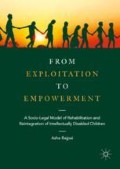Abstract
Following the rescue of children from gross abuse, neglect, and exploitation, Project Chunauti initiated a rehabilitation program in 2012. Interventions were designed and implemented based on the needs of the children. The project aimed at making children as independent as possible. A replicable, adaptable socio-legal model of intervention emerged. The Hon’ Mumbai High Court directed the State Government to replicate the project in all the 19 Homes for the intellectually disabled. It is currently being replicated across Maharashtra.
Author’s note: This chapter has substantial contribution from Sarita Shankaran. She is a trained social worker with two decades of experience in the area of child rights and child protection. She works with children in difficult situations, and her focus has been to work on programs that provide a continuum of care and rehabilitation interventions leading to social integration of these children. Additionally, she has made significant contributions to policy design and the JJ Act rules for children in Maharashtra. She is currently working on her PhD. She has been involved with Project Chunauti right from the project design stage and now leads the social integration component of the project.
Access this chapter
Tax calculation will be finalised at checkout
Purchases are for personal use only
Notes
- 1.
The Jai Vakeel Foundation and Research Center provides holistic services delivered by well-trained staff through a nationally recognized curriculum and an engaged parent body. The foundation aims to deliver a physical, social, and cultural environment compatible to greater learning and growth for individuals with intellectual disability. See: http://jaivakeel.org/our-story, accessed May 30, 2018.
- 2.
IQ and IQ test: Intelligence Quotient, or IQ, is a theoretical construct used by psychologists within standardized tests as a means of describing one’s intelligence level. In the most commonly-administered IQ test—the Wechsler Adult Intelligence Scale (WAIS)—an average score is 100; about 95% of IQ scores fall between 70 and 130. It is important to note that IQ is not real—is simply a philosophical construct psychologists have created to describe a subset of human functioning they believe to be subjectively important in modern society. When an IQ test is scored, three primary scores are obtained—verbal IQ, performance IQ, and the full scale IQ. The full scale IQ is what is commonly referred to as one’s “IQ score” by laypeople. https://psychcentral.com/encyclopedia/what-is-an-iq-test/ accessed 11 August 2018.
Social Quotient (SQ): An index of social maturity, based on the ratio definition of the intelligence quotient or IQ, the social quotient being defined as social age divided by chronological age, the ratio then being multiplied by 100. Hence SQ = (SA/CA) × 100. See also Vineland Social Maturity Scale. SQ abbrev. http://www.oxfordreference.com/view/10.1093/oi/authority.20110803100515392. Accessed 11 August 2018.
- 3.
National Institute of Mental Health (NIMH). See: https://www.nimh.nih.gov/health/topics/index.shtml, accessed on June 1, 2018.
- 4.
https://www.unicef.org/lifeskills/index_7308.html, accessed May 24, 2018.
- 5.
World Health Organisation (1999): Partners in Life Skills Education: Conclusions From A United Nations Inter-Agency Meeting, Department Of Mental Health Social Change and Mental Health Cluster, WHO, Geneva. http://www.who.int/mental_health/media/en/30.pdf, accessed May 28, 2018.
- 6.
The National Institute of Open Schooling (NIOS) was established in November 1989, as an autonomous organization, in pursuance of the National Policy on Education (1986) by the Ministry of Human Resource Development (MHRD), Government of India. NIOS is providing a number of vocational , life enrichment, and community oriented courses, besides general and academic courses at the secondary and senior secondary level. It also offers elementary-level courses through its Open Basic Education Programmes. The OBE Programme provides elementary education for school dropouts and neo-literates, and for out of school learners through accredited agencies.
The OBE Programme is offered at three levels:
-
OBE level A: equivalent to class I–III,
-
OBE level B: equivalent to class IV–V,
-
OBE level C: equivalent to class VI–VIII,
-
http://nios.ac.in/departmentsunits/academic/open-basic-education-(obe).aspx, accessed May 27, 2018.
-
- 7.
Occupational Therapy is a holistic evidence-based, client-centered first contact and/or referral profession of modern health care system, based on science of occupation, with primary focus on purposeful goal-oriented activity/occupations, enhanced with the use of latest technological systems for evaluation, diagnosis, education , and treatment of the patients (clients) of any age group, whose function(s) is (are) impaired by physical, psychosocial, and cognitive impairments, development disorders, or the aging process affecting their quality of life, with the aim to prevent disability , promote health and well-being, and return to optimum occupational roles.
Specific occupational therapy services include but are not limited to: preventive health literacy, assessment and interventions in activities of daily living (ADL), work and productive activities, play , leisure, and spiritual activities; functional capacity analysis, prescription, designing, and training in the use of assistive technology, adaptive equipment and splints, and environmental modifications to enhance functional performance (Indian Occupational Therapists Association, 2017) (Iota.org/Home/AboutOT, accessed May 28, 2018).
- 8.
Henna or Mehndi designing means decorating hands and feet with designs made out of mehndi and henna powder.
- 9.
Pratham is an innovative learning organization created to improve the quality of education in India. As one of the largest non-governmental organizations in the country, Pratham focuses on high-quality, low-cost, and replicable interventions to address gaps in the education system. Established in 1995 to provide education to children in the slums of Mumbai, Pratham has grown both in scope and in geographical coverage (http://pratham.org/about-us/about-pratham, accessed May 28, 2018).
- 10.
http://www.rehabcouncil.nic.in/writereaddata/mr.pdf, accessed May 28, 2018.
Author information
Authors and Affiliations
Corresponding author
Rights and permissions
Copyright information
© 2018 The Author(s)
About this chapter
Cite this chapter
Bajpai, A. (2018). Working with Children: The Processes and the Model and Its Replication. In: From Exploitation to Empowerment. Palgrave Macmillan, Singapore. https://doi.org/10.1007/978-981-13-1718-7_3
Download citation
DOI: https://doi.org/10.1007/978-981-13-1718-7_3
Published:
Publisher Name: Palgrave Macmillan, Singapore
Print ISBN: 978-981-13-1717-0
Online ISBN: 978-981-13-1718-7
eBook Packages: Law and CriminologyLaw and Criminology (R0)

